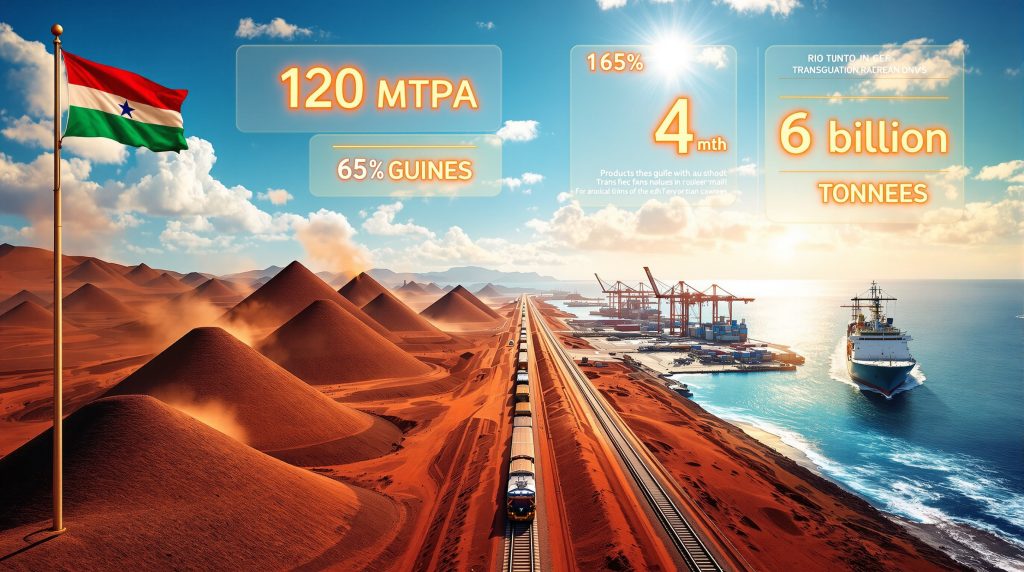Understanding Simandou's Strategic Importance in Global Iron Ore Markets
The Rio Tinto Simandou iron ore project represents one of the most significant mining developments of the 21st century, poised to fundamentally alter global iron ore supply dynamics. This massive undertaking in Guinea holds approximately 4 billion tonnes of ore reserves with an exceptional average iron content of 65%, positioning it among the world's highest-grade iron ore deposits currently under development.
Project Scale and Resource Quality Overview
The sheer magnitude of the Rio Tinto Simandou iron ore project becomes evident when examining its production targets and resource quality metrics. At full operational capacity, the combined Simandou operations are expected to produce 120 million tonnes per annum (Mtpa), with Rio Tinto's SimFer operation contributing 60 Mtpa to this total output.
| Deposit Comparison | Simandou | Pilbara (Australia) | Carajás (Brazil) |
|---|---|---|---|
| Reserve Size | 4 billion tonnes | 2.4 billion tonnes | 7.2 billion tonnes |
| Iron Content | 65% Fe | 58-62% Fe | 66-67% Fe |
| Annual Capacity | 120 Mtpa | 280+ Mtpa | 150+ Mtpa |
| Shipping Route | Atlantic Basin | Pacific Basin | Atlantic Basin |
The exceptional 65% iron content provides Simandou with a significant competitive advantage in global markets, particularly as Chinese steelmakers increasingly seek high-grade ore to improve energy efficiency and reduce emissions in their operations. This grade premium positions the project favourably against established Australian producers, whose Pilbara operations typically yield iron content ranging from 58% to 62%. Furthermore, current iron ore price trends suggest increasing demand for premium-grade ore.
Ownership Structure and Joint Venture Dynamics
The Rio Tinto Simandou iron ore project operates through a complex partnership structure that reflects the growing influence of Chinese investment in African mining operations. SimFer, which encompasses Blocks 3-4 of the broader Simandou deposit, operates as a joint venture between Rio Tinto and Chinese state-owned aluminum corporation Chalco.
Parallel to SimFer's operations, the Winning Consortium Simandou (WCS), identified as a Singaporean-Chinese consortium, controls Blocks 1-2 of the deposit. This dual-operator structure creates an interesting competitive dynamic within the same geological formation, with both entities racing to capture early market share as production commences.
The strategic positioning of Chinese state enterprises within both operational structures aligns with China's broader resource security objectives, particularly given that Chinese steelmakers consume over 70% of seaborne iron ore globally. This arrangement ensures Chinese interests maintain significant influence over a project that could reshape global iron ore supply patterns.
How Will Simandou's Infrastructure Transform West African Mining?
The TransGuinéen Railway Engineering Marvel
The Rio Tinto Simandou iron ore project's success hinges on the completion of Guinea's most ambitious infrastructure undertaking: a 600-kilometer (373-mile) heavy haul railway connecting the remote Simandou deposits to Atlantic shipping routes. This engineering achievement represents far more than a transportation link; it establishes the foundation for Guinea's emergence as a major iron ore exporting nation.
The railway's heavy haul classification indicates its design specifications accommodate the massive tonnages required for viable iron ore exports. With first ore loaded on rail transport in October 2025, the infrastructure has transitioned from construction to operational phase, marking a critical milestone in the project's development timeline.
Key Railway Specifications:
- Length: 600 kilometers (373 miles)
- Classification: Heavy haul railway for bulk commodity transport
- Operational Status: First ore shipments commenced October 2025
- Strategic Value: Enables Guinea's entry into Atlantic basin iron ore trade
The railway's completion transforms Guinea from a landlocked mining operation into a competitive Atlantic basin iron ore supplier, fundamentally altering West African mining logistics capabilities.
Dual Port Strategy for Global Export Markets
The Rio Tinto Simandou iron ore project employs a sophisticated dual-port export strategy that maximises operational flexibility while minimising infrastructure risks. Rio Tinto initially routes its SimFer exports through port infrastructure owned by partner Winning Consortium Simandou, whose deepwater terminal approaches completion.
This arrangement allows Rio Tinto to commence exports while potentially developing independent port capacity for future operations. Additionally, this strategic approach is being monitored by industry observers as miner demand perspectives continue to evolve globally. The WCS port's strategic location provides direct Atlantic Ocean access, offering significant shipping route advantages compared to Indian Ocean ports serving Australian and some Brazilian operations.
| Port Facility | Operator | Capacity Planning | Shipping Routes |
|---|---|---|---|
| WCS Terminal | Winning Consortium | Supports 120+ Mtpa | Atlantic to Asia/Europe |
| SimFer Port | Rio Tinto (Planned) | 60+ Mtpa potential | Direct Atlantic access |
| Comparison: Dampier | Australian miners | 170+ Mtpa | Pacific routes only |
The Atlantic shipping route provides notable advantages for serving both European steel producers and Asian markets via the Suez Canal, potentially reducing transportation costs and delivery times compared to Cape of Good Hope routing required for some competitors.
What Production Milestones Signal Simandou's Market Entry?
Current Stockpile Achievements and Export Timeline
The Rio Tinto Simandou iron ore project has achieved a significant operational milestone with 2 million tonnes of high-grade ore stockpiled according to industry sources, though Rio Tinto's official third-quarter production report documented 1.5 million tonnes. This stockpile accumulation represents the culmination of years of development work and positions the project for its inaugural shipment.
Critical Timeline Milestones:
- October 2025: First ore loaded onto rail transport system
- Mid-November 2025: Target date for first vessel loading
- November 11, 2025: Formal project commissioning planned by Guinea's government
- 2026-2028: Production ramp-up toward full capacity
The inaugural shipment, expected to head to China as the world's dominant steel producer, marks Guinea's entry into the seaborne iron ore trade. This milestone carries significance beyond the immediate commercial transaction, establishing Simandou as an active participant in global iron ore price discovery mechanisms.
WCS commenced ore stockpiling in September 2025, creating competitive dynamics within the Simandou complex as both operators position for early market share capture. This parallel development accelerates Guinea's emergence as a meaningful iron ore supplier while potentially intensifying downward pressure on global pricing structures. However, such iron haulage operations demonstrate the critical importance of operational safety and reliability in remote mining locations.
Capacity Scaling and Market Share Projections
The Rio Tinto Simandou iron ore project's production scaling follows a carefully planned trajectory designed to optimise operational efficiency while managing market impact. SimFer's contribution of 60 Mtpa at full capacity represents half of Simandou's total 120 Mtpa potential, with the remainder coming from WCS operations.
Production Scaling Timeline:
- 2025: Initial shipments and operational proving
- 2026: Production ramp-up toward commercial volumes
- 2027: Sustained production increase
- 2028: Target achievement of 120 Mtpa combined capacity
Industry analysts project that reaching 120 million tonnes annual output by 2028 would increase seaborne iron ore supply by 8-9%, representing one of the most significant supply additions in recent mining history. This substantial supply injection carries implications for established producers and global pricing mechanisms. Consequently, this development must be viewed alongside the largest iron ore mines currently operating worldwide to understand its relative market impact.
The phased approach allows both operational optimisation and market adaptation, reducing risks associated with rapid capacity additions while ensuring sustainable long-term production levels that justify the massive infrastructure investments required.
How Could Simandou Reshape Global Iron Ore Pricing Dynamics?
Premium Grade Ore Market Positioning
The Rio Tinto Simandou iron ore project's 65% iron content positions it squarely within the premium grade category, offering steelmakers significant operational advantages that extend beyond simple iron content metrics. This high-grade ore reduces energy consumption in blast furnace operations, decreases slag production, and improves overall steelmaking efficiency.
Chinese steelmakers, experiencing margin pressures amid a prolonged property sector downturn, are actively pivoting toward lower-cost, high-grade ore to reduce emissions and energy consumption. This demand pattern shift creates favourable market conditions for Simandou's ore quality profile, potentially supporting price premiums over benchmark grades.
Premium Ore Advantages:
- Reduced coke consumption in blast furnace operations
- Lower energy requirements for steel production
- Decreased environmental emissions per tonne of steel produced
- Improved operational efficiency through reduced processing requirements
The environmental benefits become increasingly important as steel producers worldwide face mounting pressure to reduce carbon footprints. High-grade ore like Simandou's enables steelmakers to achieve emission reduction targets while maintaining production efficiency.
Impact on Established Producers
Industry experts anticipate that the Rio Tinto Simandou iron ore project's market entry could create significant pricing pressure if established Australian and Brazilian producers fail to respond strategically to the supply increase. The addition of 8-9% to seaborne supply by 2028 represents a substantial market shift requiring industry adaptation.
Rio Tinto's finance chief Peter Cunningham indicated in July 2025 that Simandou's launch would likely force some higher-cost suppliers out of the market, suggesting a fundamental restructuring of the global iron ore cost curve. This assessment implies that marginal producers operating at higher cost structures may face viability challenges. Meanwhile, the broader implications of such iron ore surplus effects continue to influence market expectations globally.
Potential Market Responses:
- Cost reduction initiatives by established producers
- Operational efficiency improvements across existing operations
- Mine closure decisions for higher-cost marginal suppliers
- Strategic consolidation within the iron ore sector
The competitive dynamics created by Simandou's entry may accelerate industry consolidation while rewarding the most efficient operators. Australian Pilbara producers, with their scale advantages and established infrastructure, may be best positioned to respond, while smaller, higher-cost operations face increasing pressure.
What Economic Benefits Will Simandou Deliver to Guinea?
National GDP Growth Projections
The Rio Tinto Simandou iron ore project represents a transformational economic opportunity for Guinea, with the International Monetary Fund projecting a 26% increase in Guinea's GDP by 2030 as a direct result of the project's development and operation. This projection reflects the massive scale of economic activity generated by a world-class mining operation and its supporting infrastructure.
The economic impact extends far beyond direct mining revenues, encompassing railway operations, port activities, supply chain development, and the multiplier effects of increased employment and local spending. Guinea's emergence as a major iron ore exporter fundamentally alters the country's economic profile and export composition.
| Economic Impact Category | Projected Benefit | Timeline |
|---|---|---|
| GDP Increase | 26% by 2030 | Long-term |
| Export Diversification | Beyond bauxite dominance | Immediate |
| Infrastructure Development | Railway and port assets | Completed/Ongoing |
| Regional Integration | Enhanced trade corridors | Long-term |
The project's commissioning on November 11, 2025, as planned by Guinea's military government, represents a significant milestone in the country's economic development strategy. This formal recognition underscores the project's importance to national economic planning and regional development objectives.
Regional Development and Social Investment
Beyond direct economic metrics, the Rio Tinto Simandou iron ore project catalyses broader regional development across Guinea's mining corridor. The railway and port infrastructure create permanent assets that support future mining developments and general economic activity throughout the region.
The project's debut coincides with China's expanding influence in Guinea's resource sector, building upon existing leadership in bauxite exports. This strategic positioning creates opportunities for integrated resource development while establishing Guinea as a key supplier within China's resource security framework.
Regional Development Benefits:
- Permanent infrastructure assets supporting future economic activity
- Skills development programmes building local technical capacity
- Supply chain opportunities for local businesses and contractors
- Transportation network enhancement connecting remote regions
The transformation from a primarily bauxite-focused mining economy to a diversified mineral exporter strengthens Guinea's economic resilience while reducing dependence on single commodity price cycles.
Which Market Forces Drive Simandou's Strategic Timing?
Chinese Steel Industry Demand Patterns
The Rio Tinto Simandou iron ore project's market entry aligns strategically with evolving demand patterns in China's steel industry, where producers face mounting pressure to improve operational efficiency while reducing environmental impact. Chinese steelmakers, constrained by margin pressures and a prolonged property sector downturn, are actively seeking high-grade ore solutions that deliver operational advantages.
The shift toward lower-cost, high-grade ore consumption reflects steel industry adaptation to regulatory pressures for emissions reduction and energy efficiency improvements. Simandou's 65% iron content directly addresses these requirements, offering Chinese steel producers the quality specifications needed for optimised operations.
Chinese Steel Industry Drivers:
- Margin pressure from economic slowdown and property sector weakness
- Environmental regulations requiring emissions reductions
- Energy efficiency mandates driving high-grade ore demand
- Operational cost optimisation through improved raw material quality
China's consumption of over 70% of seaborne iron ore provides Simandou with a substantial and accessible market for its high-grade production. The strategic timing capitalises on Chinese steelmakers' evolving procurement strategies that prioritise ore quality over price alone.
Global Decarbonisation and Ore Quality Preferences
The Rio Tinto Simandou iron ore project benefits from global steel industry trends toward decarbonisation, where high-grade ore plays a crucial role in reducing carbon emissions per tonne of steel produced. Steel producers worldwide face increasing pressure to demonstrate environmental progress, creating sustained demand for premium-grade iron ore.
The environmental advantages of high-grade ore extend beyond simple carbon footprint reduction to encompass broader operational efficiency improvements that align with sustainable steel production objectives. These factors support long-term demand sustainability for Simandou's ore quality profile.
The convergence of environmental regulations, operational efficiency requirements, and cost optimisation objectives creates a favourable demand environment for high-grade iron ore suppliers like Simandou.
Decarbonisation Trends Supporting Simandou:
- Carbon intensity reduction requirements for steel producers
- Energy efficiency mandates across major steel-producing regions
- Supply chain diversification strategies reducing geographic concentration
- ESG investment criteria favouring sustainable mining operations
What Challenges and Risks Face Simandou's Development?
Historical Development Obstacles
The Rio Tinto Simandou iron ore project's path to production reflects the complex challenges inherent in developing world-class mining projects in remote locations with limited existing infrastructure. The project's evolution through various ownership structures and development phases demonstrates the persistence required to bring such ambitious undertakings to fruition.
Operational complexity emerges as a significant ongoing challenge, reflecting the remote location, massive infrastructure requirements, and coordination demands between multiple operators within the same geological formation. The dual-operator structure, while providing competitive benefits, also creates coordination complexities for shared infrastructure utilisation.
Key Development Challenges:
- Remote location logistics requiring comprehensive infrastructure development
- Multi-operator coordination within shared transportation systems
- Regulatory compliance across multiple jurisdictional frameworks
- Financing complexity for massive capital requirements
The successful transition from construction to operational phase, marked by first ore loading in October 2025, demonstrates the project's ability to overcome historical obstacles while establishing operational capabilities.
Market Competition and Pricing Pressures
The Rio Tinto Simandou iron ore project faces competitive responses from established producers who may implement strategic initiatives to maintain market share as new supply enters global markets. The projected 8-9% increase in seaborne supply by 2028 creates sufficient market impact to trigger competitive reactions.
Rio Tinto initially routing exports through WCS-owned infrastructure creates operational dependencies that could affect flexibility and cost structures during the critical early operational phase. This arrangement, while enabling faster market entry, introduces third-party risks that could impact operational control.
Market Competition Factors:
- Established producer cost reduction initiatives in response to new supply
- Transportation cost optimisation requirements for competitive positioning
- Currency volatility affecting project economics and pricing
- Commodity price cycles impacting long-term project viability
The competitive landscape evolution requires continuous operational efficiency improvements and strategic positioning to maintain competitive advantages as market dynamics adjust to increased supply availability.
How Does Simandou Position Guinea in Global Mining?
Resource Sector Diversification Strategy
The Rio Tinto Simandou iron ore project fundamentally transforms Guinea's position in global mining markets, establishing the country as a significant iron ore supplier beyond its traditional bauxite export dominance. This diversification reduces economic dependence on single commodity cycles while positioning Guinea within multiple critical mineral supply chains.
China's expanding influence in Guinea's resource sector, already evident in bauxite operations, extends through Simandou's development via state-owned enterprise participation. This strategic positioning creates integrated resource development opportunities while aligning Guinea's mineral exports with China's resource security objectives.
| Mineral Export Evolution | Pre-Simandou | Post-Simandou | Strategic Impact |
|---|---|---|---|
| Bauxite | Dominant export | Continued strength | Diversification base |
| Iron Ore | Minimal | Major export | Economic transformation |
| Other Minerals | Limited | Potential expansion | Infrastructure leverage |
The railway and port infrastructure created for Simandou provides foundation assets that could support future mining developments, positioning Guinea as a regional mining hub with established Atlantic shipping access.
Geopolitical Implications for Iron Ore Trade
The Rio Tinto Simandou iron ore project establishes Guinea as an Atlantic basin iron ore supplier, creating new geographic options for steel producers seeking supply source diversification. This development reduces global iron ore trade's geographic concentration while providing alternative supply routes that enhance market resilience.
The project's success demonstrates the viability of developing world-class mining operations in West Africa, potentially encouraging additional mineral development projects across the region. Guinea's emergence as a major iron ore exporter may catalyse broader regional mining investment and infrastructure development through initiatives documented by Rio Tinto's official project updates.
Geopolitical Implications:
- Supply route diversification reducing dependence on traditional exporters
- Atlantic basin positioning offering shipping advantages to multiple markets
- Regional development catalyst demonstrating West African mining potential
- Strategic mineral security enhancing global supply resilience
The establishment of reliable iron ore supplies from Guinea contributes to global supply security while providing importing nations with additional sourcing options that enhance negotiating positions and supply chain resilience.
What Investment Opportunities Emerge from Simandou's Success?
Direct Mining Investment Considerations
The Rio Tinto Simandou iron ore project's successful transition to production validates the investment thesis for world-class African mining developments while demonstrating the potential returns from patient capital deployment in complex infrastructure-dependent projects. The project's 4 billion tonne resource base and 120 Mtpa production potential represent substantial asset values that justify the massive infrastructure investments required.
Rio Tinto's strategic positioning within SimFer provides exposure to both the high-grade ore production and the supporting infrastructure assets, including railway and port facilities that generate long-term value beyond the mine life. These infrastructure assets create competitive advantages for future mining developments in the region.
Investment Opportunity Categories:
- Direct mining operations through established producers like Rio Tinto
- Infrastructure asset exposure via transportation and port facilities
- Supply chain development supporting local contractor and supplier networks
- Regional mining expansion leveraging established infrastructure
The successful development model established by Simandou provides a template for additional African mining projects, potentially creating opportunities for investors willing to support long-term development strategies in emerging mining regions.
Broader Economic Development Investments
The Rio Tinto Simandou iron ore project catalyses investment opportunities across Guinea's broader economy, particularly in transportation, logistics, and port services sectors that support mining operations. The 26% GDP increase projected by 2030 reflects the broad economic multiplier effects that create investment opportunities beyond direct mining activities.
Regional economic integration prospects emerge as the railway and port infrastructure connects previously isolated regions to global trade networks. These connectivity improvements support agricultural development, manufacturing opportunities, and service sector growth that benefit from enhanced transportation access.
Economic Development Investment Areas:
- Transportation services supporting expanded trade volumes
- Port and logistics operations handling diverse commodity flows
- Manufacturing development leveraging improved infrastructure access
- Service sector expansion supporting increased economic activity
The transformation of Guinea's economic profile creates opportunities for investors focused on frontier market development and infrastructure-driven growth strategies that capitalise on emerging market potential.
Simandou's Role in Future Iron Ore Markets
Long-term Market Transformation Outlook
The Rio Tinto Simandou iron ore project represents a fundamental shift in global iron ore market structure, establishing Guinea as a permanent participant in seaborne iron ore trade while demonstrating the viability of developing world-class African mining operations. The project's success validates investment strategies focused on high-grade ore production and integrated infrastructure development.
Supply base diversification achieved through Simandou's development enhances global iron ore market resilience while providing consumers with additional sourcing options that reduce geographic concentration risks. The Atlantic shipping routes offer strategic advantages for serving multiple regional markets efficiently.
Quality premium market development becomes increasingly important as steel producers worldwide prioritise ore grades that support environmental compliance and operational efficiency objectives. Simandou's 65% iron content positions the project favourably within these evolving market dynamics.
Long-term Market Implications:
- Geographic diversification reducing market concentration risks
- Quality premium recognition supporting high-grade ore valuations
- Competitive landscape evolution driving efficiency improvements across the industry
- Sustainable mining advancement through environmental performance focus
The project's successful development establishes precedents for future African mining projects while contributing to global supply security through reliable, high-quality production from a strategically positioned Atlantic basin supplier.
This analysis is based on publicly available information and industry reports. Mining investments carry inherent risks including commodity price volatility, operational challenges, and regulatory changes. Potential investors should conduct independent research and consider professional advice before making investment decisions.
Looking to Capitalise on Major Mining Developments?
Discovery Alert's proprietary Discovery IQ model delivers instant notifications on significant ASX mineral discoveries, enabling subscribers to identify actionable opportunities ahead of the broader market. Experience how major mineral discoveries can generate substantial returns by exploring Discovery Alert's dedicated discoveries page, and begin your 30-day free trial today to secure your competitive advantage in mining investments.




